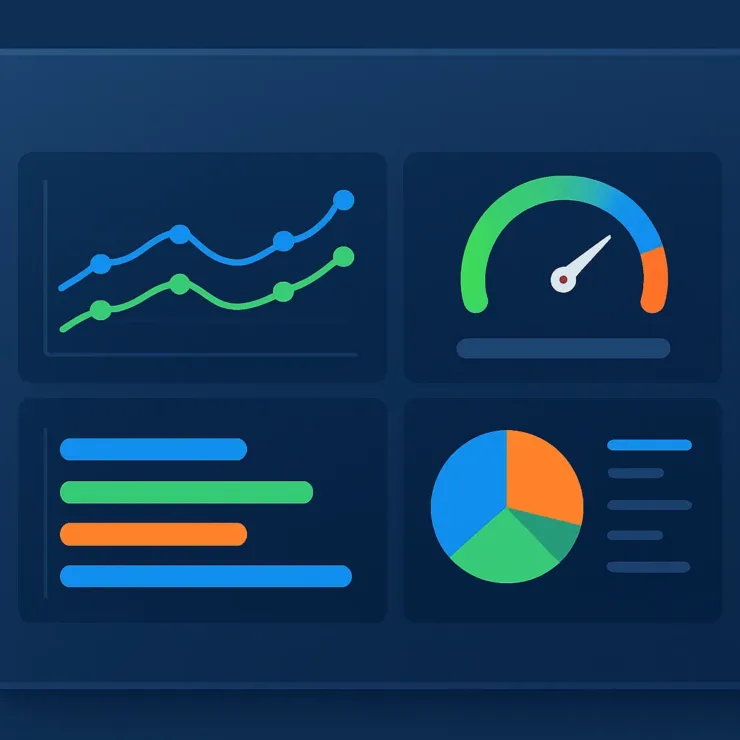In today’s world, customers have more choice than ever. They can choose a range of businesses to buy products and services. Plus with the ever-increasing cost of acquiring new customers, the loyalty of your existing customers towards your brand matters a whole lot. Customer loyalty is an abstract concept; loyalty is an emotion that your customers “feel” towards your brand. How can we measure it more objectively? This post explores several customer loyalty metrics that can help you measure loyalty. We will also explore various ways to improve your customer loyalty so that you can take the necessary actions to improve upon these customer loyalty metrics.
Why measure customer loyalty metrics? Benefits of Customer Loyalty
We all understand that the loyalty of your existing customers is extremely important. Let’s see some data that can quantify the importance of customer loyalty. In the apparel segment, an average customer spent 67% more in the months between 31 – 36 than between 0 to 6 months. This means the older the customer, the more the possibility of a higher spend. Looking at the repeat purchase data from a little different angle, this study by Bain found that in the apparel segment, customer’s fifth purchase was 40% more than the first purchase. The tenth was nearly 80% more than the first one!
Ok, that is some data. Now let’s put down the key benefits of building a loyal customer base.
Repeat Purchase
Loyal customers of a brand keep purchasing from it unless something goes terribly wrong. Though today’s customers have more choices, choosing from a wide range of options can become challenging. This is explained well in this study. So if your customers are feeling loyal towards your brand, they are more likely to buy from you instead of looking out for one of your competitors.
Higher Spending
Not only do your loyal customers purchase repeatedly from you, but also they are more likely to spend more. This is captured in the study by Bain as noted above. That means not only higher revenue for your business but also higher profitability.
Cross-Purchase
If you sell multiple products, loyal customers can try out the other products. This can help increase sales of other products from your business.
Save on Marketing Cost
Today many of the marketing channels are way more competitive than they used to be 10 years back. On platforms like Google, FB, or Instagram, where marketers bid for keywords, the competition also increases the cost per click. While you have to pay more to acquire new customers, having a loyal customer base can become crucial to keeping marketing costs low.
Less likely to Churn
If you are running a SaaS business, customer churn is one of the top metrics you may be tracking. Loyal customers are way less likely to churn. If a customer is using your product for months or years, they are more likely to stay on if they are happy and satisfied. Also, if there is an issue with your product or service, the set of loyal customers should be more tolerant and understanding.
Getting more Referrals
Loyal customers are more likely to refer more customers to your business. However, for the referral to work seamlessly, you may need to have a well-structured referral program in place.
What are the top customer loyalty metrics?
Now that we have identified some of the top benefits of having loyal customers, let’s explore how to measure customer loyalty. Loyalty is not easy to measure, unlike financial metrics like Revenue growth or Profitability. Loyalty of your customers is an emotional connection that they have towards your brand. However, you can measure some of the key metrics, that can serve as a proxy for customer loyalty.
1. Net Promoter Score (NPS) - One of the top customer loyalty metrics
Net Promoter Score or NPS is one of the most universally adopted measures of customer experience. The NPS system was invented at Bain & Co. and is a widely popular metric to measure both Customer and Employee experience. The NPS question is an 11-point scale asking the customer of the likelihood of recommending their business to others. More specifically an example NPS question can be –
How likely are you to recommend <your brand/product/service> to your friends and family?
The customer can choose a scale ranging from 0 to 10. Customers choosing between 0 to 6 are called Detractors, 7 and 8 are Passives and 9 and 10 are Promoters.
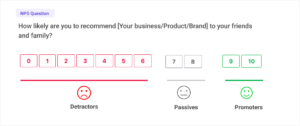
Promoters: Promoters are the ones who chose 9 or 10 for the NPS question. These customers are the happiest ones with your product or service. They are loyal to your brand and are most likely to share your brand with their network. They not only stay longer and buy more but also refer others to your business.
Passives: Passives are the ones who have rated 7 or 8 for the NPS question. These customers are neutral in their outlook towards your brand. They may neither recommend your brand to someone nor talk bad about you. As a business, your goal should be to convert as many people in this bucket to promoters by delighting them.
Detractors: Detractors are those respondents who have chosen 6 or lower (0 to 6). Detractors have most likely faced issues with your product/service. They are least likely to refer anyone to your brand. Moreover, they may talk negatively about your brand within their network and post bad reviews on the review sites. So, it is very important to find out their issues, and address and resolve them immediately.
How to calculate NPS?
NPS can be calculated by a simple subtraction –
NPS Formula – (% of Promoters in the Response – % of Detractors in the Response).
Below is an example of how to calculate NPS. Let’s say 100 customers respond to your NPS survey. Out of them 70 were promoters (Score of 9 and 10), 20 were Passives (7 & 8), and 10 Detractors (0 – 6). In the above example, Percentage of Promoters = 70%, Percentage of Detractors = 10%. So the NPS is (70 – 10) = 60.

With Affiniv, you can create beautiful surveys and send them instantly via Email or Embed in your website/app.
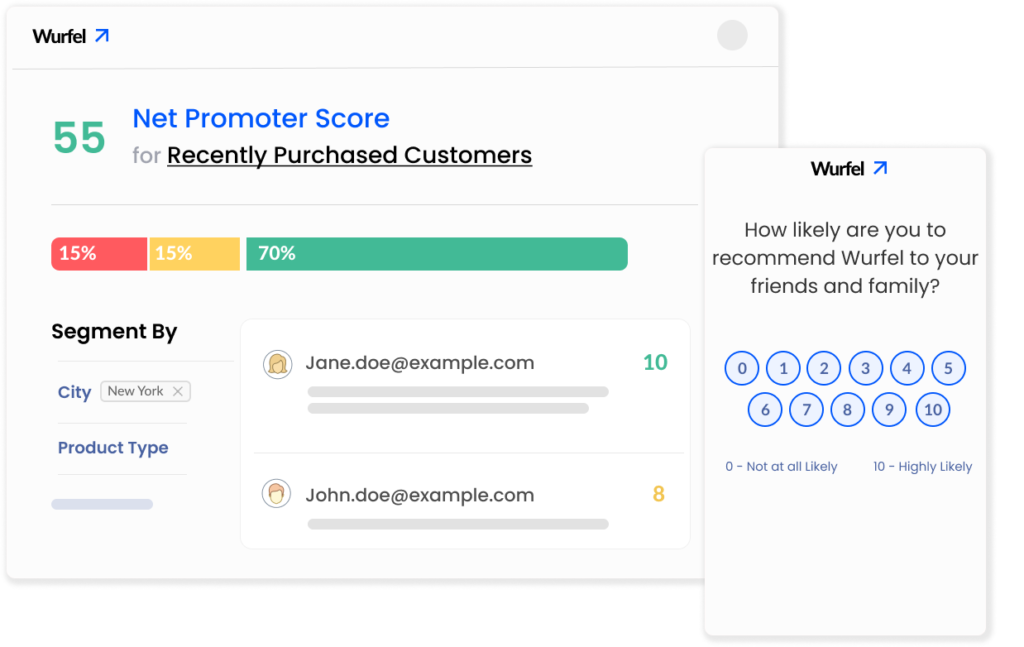
2. Customer Satisfaction Score (CSAT) - One of the next-level customer loyalty metrics
As the name suggests, the Customer Satisfaction Score, or CSAT is used to measure customer satisfaction at multiple touchpoints. Generally, the CSAT survey is a 5-point scale survey asking customers about their experience with a recent purchase or interaction. For example, you may choose to send a CSAT survey after a few days of someone receiving their order, using a product feature, contacting your support, and so on. Customers responding 1 and 2 are dissatisfied or unhappy. 3 are Neutral. 4 and 5 are Satisfied or Happy.
Example questions can be –
CSAT Example Question: Please rate your experience with your recent [order/transaction/feature use]
Scale 1 – 5.
1 – Very Poor
5 – ExcellentCSAT Example Question: Please rate your recent experience with our support desk.
Depending on the score selection, your users can be classified into 3 buckets as follows –
Dissatisfied: Score of 1 & 2. These customers did not like their recent interaction or transaction with your business. They may or may not be the detractors of your brand, but they did not like this particular experience.
Neutral: Score of 3. They were not dissatisfied but not very satisfied with the recent transaction or interaction with your business
Satisfied: 4 & 5. These customers were happy with their recent interaction. But it may be a mistake to think that all of the customers in this bucket are your brand promoters or they like your business overall. As your CSAT is tied to a particular context or transaction, it simply means that they found this transaction, interaction, or feature satisfying.
Can the CSAT score be one of the customer loyalty metrics?
The CSAT survey is used in the context of a transaction and may not be very suitable to measure overall customer loyalty. However, a collection of CSAT scores measured at various touchpoints may be suitable as customer loyalty metrics. Here is a post to help you understand more details on when to use NPS vs CSAT.

3. Customer Effort Score (CES)
The Gartner article titled – “Effort is the strongest driver to customer loyalty” gave momentum to the concept of CES or “Customer Effort Score”.
In simple language, it means – how easy it was for your customer to use a particular feature, carry out a particular transaction, place an order, etc.
Some CX industry people classify it as a separate kind of survey, while others treat it more like a special case of CSAT.
Irrespective of the point of view, the question and survey methodology remains the same in the case of CES as in the case of CSAT.
CES is also a 5-point scale, with the main question as follows.
CES Question: How easy was it for you to [use feature X/place order on website/do Y transaction]?
1 – Very hard
5 – Very easy
In our view, CES should be treated at the same level as CSAT to establish your customer loyalty metrics. A combination of multiple CES and CSAT scores at various touchpoints needs to be considered for the purpose.
4. Customer Lifetime Value (CLV)
Customer lifetime value or CLV is another key metric to establish customer loyalty. In simple terms, CLV tells you what is the value that get from an average customer. It’s the combination of all profits across a time period. Let’s provide 2 examples from two different industries to explain it to you.
E-commerce example: In the case of an e-commerce business, assume your average order value is $100 (for the sake of simplicity of calculation). And your margin per order is 40%. So your margin from an average order is $40. Now let’s assume an average customer places 8 orders in her lifetime with you. So the customer lifetime value is $40 * 8 = $400.
Some customers place only a few orders and some keep placing orders month after month. If the business has been running for a little longer period, you can arrive at the average number of orders by using the simple formula as – (Total number of orders in a period / Total number of customers during the period). Say in a period of 2 years, your business received 200K orders from 20K customers. In this case, the average number of orders per customer is 10.
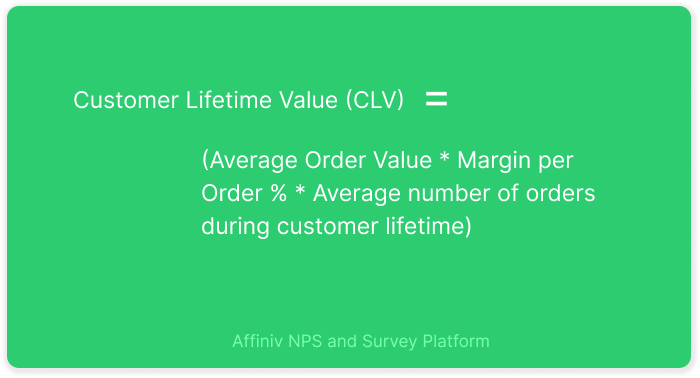
SaaS example: In the case of a SaaS business, calculating CLV is straightforward. Let’s assume the retention duration for an average customer is 30 months. Average monthly revenue per customer is $100 with a margin of 70%. To calculate the CLV, you can simply multiply the (margin per customer per month * average customer retention duration in months). In this example, the CLV is ($70 * 30) = $2100.
5. Customer Retention Rate (CRR)
Customer Retention Rate is one of the key Customer Loyalty Metrics, particularly when it comes to SaaS business. It measures the percentage of customers you are able to retain in a particular time period.
Let’s consider an example – Say at the beginning of the year 2023, i.e. on 01 Jan 2023, you had 200 customers. At the end of the year 2023, that is on 31st Dec 2023, you ended up with a total of 280 customers. Out of these, say 120 are new customers. In this example, the old customers from 01-Jan-23 you retained for the year 2023 are (280 – 120) = 160. To calculate the CRR, you can simply use the formula – (Number of existing customers retained during the period / Number of customers at the beginning of the period * 100). So in this case the CRR for the year 2023 = (180/200 * 100) = 80%.
The formula for CRR for a period = (Total number of customers at the end of the period – Total number of new customers during the period)/(Number of customers at the beginning of the period) * 100.
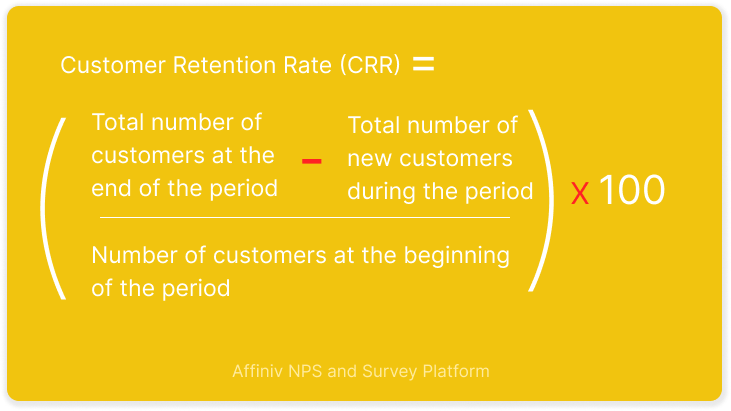
As is evident, for SaaS business, the customer retention rate is one of the key customer loyalty metrics. In the above example, though the business has grown from 200 to 280, which is a 40% growth, it’s customer retention rate is only 80%. So it may be having a customer retention issue, that may need to addressed through improvements in product or services.
Sometimes in high growth SaaS companies, the new customer growth can shadow the retention of the older customers. New customer acquisition is an expensive process. So unless the existing customers are retained, the profitability of the business may suffer. Also, a great customer retention number points to a healthy product-market fit and vice versa. Hence businesses like SaaS should keep a close eye on this metric.
Customer Retention Rate vs Customer Churn Rate
Customer churn rate is the exact opposite of customer retention rate. If customer retention rate for a period is 90%, the Churn Rate is 10%. In simple terms, it means what percentage of your existing customers in the beginning of a particular period leaves or churns.
6. Repeat Purchase Rate (RPR)
Repeat purchase rate is one of the customer loyalty metrics. It shows how loyal your customer base is by measuring the percentage of repeat customers in your base within a specific time period. For example, say for a particular year, 200 customers buy items from your e-commerce store. Out of the 200 customers, say 50 customers purchased more than once. So the repeat purchase rate is (50 / 200) = 25%.
Formula for Repeat Purchase Rate = (Number of customers purchased more than once in a period / Total number of customers purchased in that specific period)
Higher repeat rate for a period means that you have a loyal customer base purchasing from you. In this case you don’t have to spend on expensive marketing to acquire new customers to grow your business.
7. Purchase Frequency
Purchase frequency is also a measure of customer loyalty, especially in the e-commerce business. Purchase frequency is the average number of times a customer buys from a brand within a specific time period. To measure purchase frequency, you can simply divide the total number of orders in that period and the number of unique customers who purchase within that time period.
Let’s consider this example – say in a particular month an e-commerce business gets 10K orders. Total number of customers who purchased from the store is 4K. To put in other words, 4000 customers placed 10000 orders. So the purchase frequency is (10k / 4k) = 2.5.
To put it in formula – Purchase Frequency = Total number of Orders for a Period / Number of Unique customers for the period
As with RPR, Purchase frequency of PF is an essential measure of customer loyalty. A high purchase frequency number means that the existing customers are purchasing more from the brand. This can typically lead to better margins and revenue growth for the brand.
How to increase customer loyalty? Improving the customer loyalty metrics
Now that we have identified several customer loyalty metrics, it’s time to dive a little deep into how to actually increase customer loyalty. Here are some of the things you should look at, which may contribute to an increase in the same.
High-quality product or Service
Depending on type of your business customers are buying your products or services. Whether you are an e-commerce brand or SaaS business, providing high quality products for your customers is the most important way to establish loyalty. Providing high quality product makes sure that customers keep using them or keep coming for more. If you are a SaaS business, you should make sure that your product solves the customer needs as promised, is fast and error-free. In the age of highly competitive software market, providing a high-quality product is a must if you want to retain your customers.
Ethical Products
Over the past decade there has been an increased awareness about environment-friendly, cruelty-free, and ethically-sourced products in several consumer segments. If your business sells them, there is good chance that your customers view you in positive light and become more loyal towards your brand.
Amazing Customer Support & Service
Customer support and service is an essential part in most types of businesses. For a SaaS businesses, the initial onboarding and integration, support tickets, bug fixes, etc, are some of the areas needing human touch. For an e-commerce business, areas like exchange/returns, delivery issues, product issues/information, etc, may be some of the frequent areas for your support team.
Most businesses treat the customer purely as a “cost center” and rightly so. But these support interactions are a great chance for a business to create a memorable and lasting information in customer’s mind. A highly informative response from a support agent or a speedy resolution of a support ticket are some of the sureshot ways to increase customer loyalty. There are companies like Zappos that put the support at the heart of their business and built a great customer-centric company. In case of a SaaS or Software business, providing outstanding customer service is a great way to gain customer trust and stand out against the more established competitors.
Excellent Return policy like Amazon
Similar to customer service, returns also cost businesses money. But a great return policy helps build customer loyalty toward the brand. The customers who go through a hassle-free returns process can potentially become loyal customers and spread the word about your brand.
Community and Engagement
Customers like to share their experience and respond to similar queries/issues they face in their lives. Enabling a community for your customers is a great way to build interaction and engagement. This also helps build a loyal customer base. In the commerce world, some of the brands selling baby products or pet products have build excellent community. For example, new mothers have many queries, which may be answered by others and experts in a baby care forum. A baby e-commerce store can have a forum where these interactions can take place, resulting in more engagement and brand loyalty.
Similarly, SaaS business build community to answer product and tech queries. Through the community the customer queries can be responded in a faster and cost-effective manner. Plus, done well, existing customers can show their expertise and get community recognition. This works pretty well in case of developer-facing products and open-source ones.
Proactive Feedback Collection and Loop Closure
Asking for feedback from your customers is also a great way for them to feel valued and can improve the customer loyalty. The feedback collection process also gives your unhappy customers a channel so that they can voice their concerns. If the highlighted issues are resolved on time, these customers can be loyal to your business. Apart from providing many other benefits, proactive feedback collection can help you improve your customer loyalty metrics.
Brand building
Brands building improves trust in the business and also helps with top-of-the-mind recall. Both of these factors can lead to building a more loyal customer base. Also, the brand building exercise should be done in sync with providing a great product and service to increase customer loyalty.
Running a Loyalty Program
Loyalty programs are a tried and tested method to nudge the customers do more transaction with your business. Businesses in segments like airlines, travel, financial services, retail, and many more have been using loyalty program to make sure that customers keep doing more transactions and get rewarded. You can run a well-designed loyalty program so that your customer feel valued and are sufficiently incentivized to transact more with you. Again, loyalty program in itself is not sufficient to build loyalty. It can enable you to build a loyal customer base once you have put the basics in place as described above – great product, good service, proactive feedback collection, building engagement, etc.
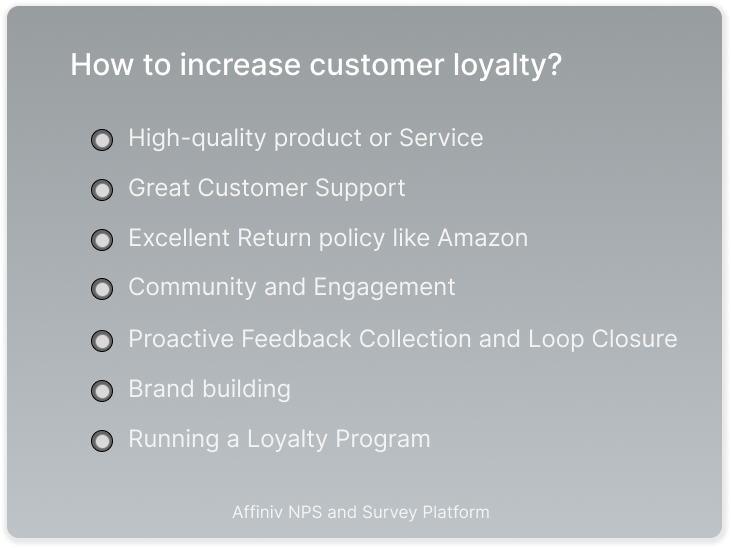
Conclusion
In this post, we have explored the top customer loyalty metrics, how to calculate them. We also touched upon the benefits of building customer loyalty and the ways to improve the same. When it comes to improving customer loyalty, many businesses think of the loyalty program. And there is nothing wrong with having a great loyalty program in place. But to truly improve the customer loyalty metrics, you need to work on the core part of the business – your products, services, customer engagement, voice-of-customer, etc.
Want to measure customer loyalty? Create and send surveys like NPS, CSAT in minutes
With Affiniv, you can create beautiful surveys and send them instantly via Email or Embed in your website/app.



